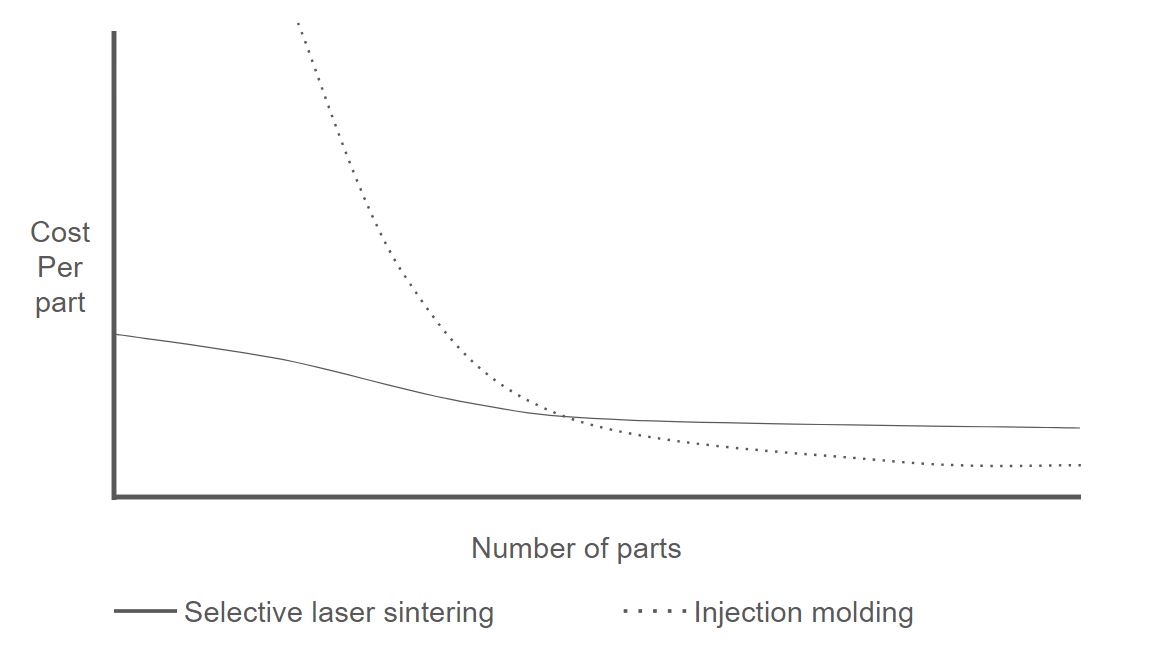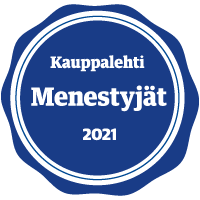HUNDREDS OF THOUSANDS OF PARTS – WHY ARE PARTS 3D PRINTED?
During the year 2023 Materflow has produced hundreds of thousands of parts by 3D printing. Why is 3D printing chosen as a production method in different industries and for manufacturing different parts and products? This is the start of a new blog series, where we will focus one by one on different reasons to choose 3D printing instead of traditional manufacturing methods.

WHY IS SERIAL PRODUCTION WITH 3D PRINTING?
90% of the products printed by Materflow are end product series. In different contexts, series production means sets of very different sizes: series production is the production of ten thousand products as well as the printing of, say, ten or twenty products.
3D printing may not be the first thing you think of as an efficient method of serial production. However, it is a popular way, for example, in the Finnish elevator and food industries, where the equipment used can be decades old, and the availability of spare parts is not good, the delivery times are long, or acquiring spare parts might not even be possible anymore.
Other typical reasons for 3D printing sets for companies are bridge production of a new part or product, life cycle cost assessment and storage challenges.
THE PRICE OF EASE – HOW MANY WORK HOURS ARE SAVED WHEN A PART IS 3D PRINTED?
3D prints are typically ordered by an engineer or company’s decision-maker who has carefully evaluated the benefits and time consumption. In this case, the reason is ease: a lot of the organization’s resources are often saved when a part is 3D printed.
3D printing may be a more expensive option than molding. Still, its ease often makes the customer choose additive manufacturing. While molding is a slow production method that requires many planning stages, 3D printing only requires a digital 3D model.
On top of that, this 3D model can be changed quickly and flexibly as needed – instead of designing, manufacturing and testing a whole new mold.
3D PRINTING OR MOLDING?
So how do you know if it makes more sense in your particular situation to design a mold or a 3D model?
It depends on many factors. The number of working hours that each method requires from the organization’s engineer or another person in a key role is one factor. Time is money. The delivery time should also be taken into account. The mold also wears out with use. It is necessary to estimate how much one mold can produce the desired parts before a new mold is needed. MOQ and other factors also can play a big role.
ENVIRONMENTAL REASONS BEHIND THE CHOICE OF 3D PRINTING
The environmental perspective favors 3D printing in many situations, even though 3D printing might not be the first thing that comes to mind as an environmental act.
First of all, delivery distances can be extremely long if parts are ordered from a factory on the other side of the world – that’s why many choose a domestic 3D printing company to produce a small series. The selection of 3D printable materials is also rapidly expanding to include recycled materials.
In addition, the philosophy that 3D printing is “on-demand” production, i.e. order batches can be very small, advocates choosing it as a production method for environmental reasons. In this way, only exactly as many parts as are definitely needed are produced at one time, and waste is reduced.
THE POSSIBILITIES OF INDIVIDUALISED PARTS IN 3D PRINTING
With 3D printing, it is possible to manufacture significantly more complex parts than with traditional machining or molding, because there are much fewer restrictions on the shape of the piece to be printed.
For example, dental and facial surgery requires complex drill guides and prostheses that are individually designed and manufactured for each patient. These can only be accomplished smoothly and cost-effectively by 3D printing.
COST SAVINGS OF 3D PRINTING COMPARED TO TRADITIONAL MANUFACTURING METHODS
One typical reason for any business-related decisions is, of course, cost. In some situations, 3D printing can be an expensive solution, but, on the other hand, it often achieves cost savings, too.
When comparing the costs of 3D printing to traditional manufacturing methods, it quickly becomes clear how expensive machining or molding can turn out to be with its labor-intensive design stages.
3D printing can also bring plain savings when looking at the life cycle costs of the produced parts.
In addition to production, the life cycle of the entire part also includes, for example, storage, the cost of which can be zero when 3D printing. 3D printing brings a new angle to inventory management. The costs of storage are not always known, but with 3D printing, capital does not have to be tied up for years to maintain the warehouse, but pieces can be produced as needed.

Additive manufacturing can be a cost effective method even for large series. The crossover with IM is highly dependent on the product design.
THE FUTURE OF INDUSTRIAL 3D PRINTING IS BRIGHT
Why will 3D printing continue in the future? Will the demand for 3D printed industrial parts and products explode?
3D printable materials are developing at a fast pace. Material costs will decrease already in the near future. In addition, printers and the technologies and equipment used for post-processing are becoming more efficient all the time – printing becomes faster and more efficient.
In the field of 3D printing, there are many operators who actively develop technology and materials to become better and more cost-effective, Materflow as one of the many Finnish active operators. Industrial 3D printing is definitely worth keeping an eye on!
COMBINING 3D PRINTING AND 3D SCANNING
The use of 3D scanning in 3D printing is modern day’s technology, and offers numerous advantages.
This combination saves yet another step in design: for example, when manufacturing spare parts for old machines, spare parts or molds, there is no longer a need to manually create a 3D model. Instead, we can make use of 3D scanning technology, which enables accurate modeling of the old part quickly and effortlessly. This combination enables a faster and more efficient manufacturing process.
POST-PROCESSING ENABLES 3D PRINTING AS THE MANUFACTURING SOLUTION
Parts produced with proper industrial post-processing achieve or exceed the standard properties. In the case of plastic parts, a specific color may be required, while for metal parts, surface quality can be a significant factor. On the other hand, safety is also ensured through proper post-processing: post-treatments provide assurance that the strength, durability, or flexibility of the printed part meets industry standards.


